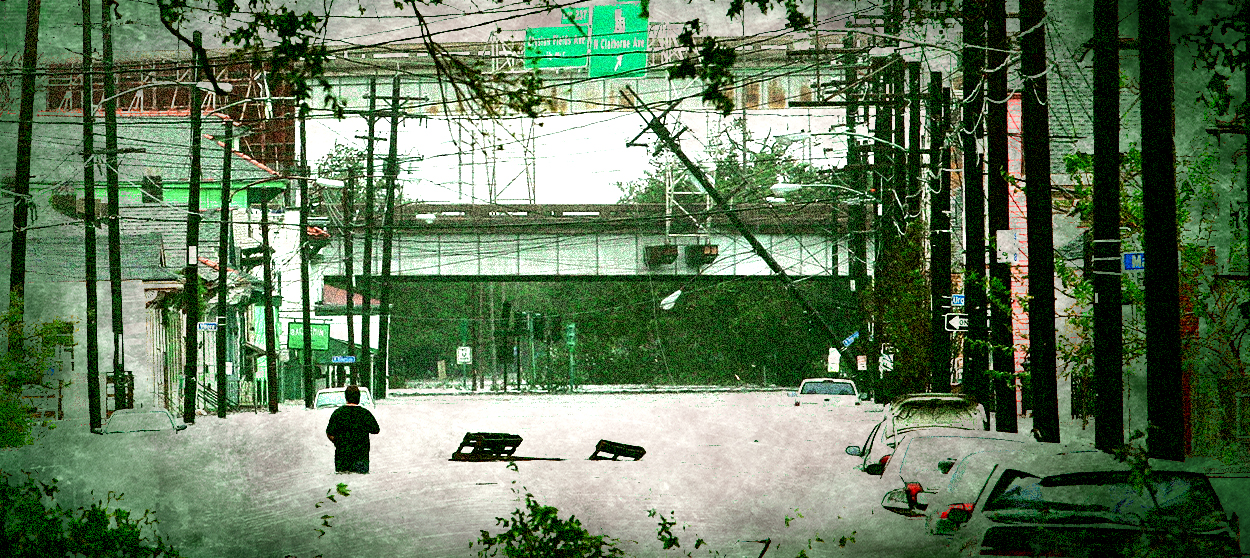How New Orleans' flooding risks are exacerbated by climate change
The region faces multiple overlapping threats that require long-term solutions


We need long-term solutions to Louisiana's flood problems.
As of this writing, Hurricane Barry was expected to make landfall as a category 1 hurricane Saturday, and it appears that New Orleans and the surrounding areas have avoided a worst-case scenario. After an extraordinarily rainy spring season, there was concern Barry's storm surge would push an already swollen Mississippi River over the city's levees. That risk has subsided for now, but the area still faces dangerous and damaging flooding, with as much as 30 inches of rainfall expected to test already-stretched systems across the state over the next few days.
The whole situation is a vivid illustration of the multiple overlapping threats the city and region face, all of which are exacerbated by climate change.
The Week
Escape your echo chamber. Get the facts behind the news, plus analysis from multiple perspectives.

Sign up for The Week's Free Newsletters
From our morning news briefing to a weekly Good News Newsletter, get the best of The Week delivered directly to your inbox.
From our morning news briefing to a weekly Good News Newsletter, get the best of The Week delivered directly to your inbox.
New Orleans can flood in a few different ways. The first is rainfall. Earlier this week, New Orleans flooded when nearly nine inches of rain fell on the city in just three hours. The streets filled with water, cars were submerged, and first stories flooded. A little over 50 percent of the city is below sea level, so when it rains the bowl begins to fill. The city has over 100 pumps that work to keep the streets dry. But when that much rain falls that fast, the pumps can't keep up and the streets flood. City officials like to remind us that no system in the world could keep up with this amount of rainfall. What do we have to do to make one that will?
The second way New Orleans can flood is from Lake Borgne and Lake Pontchartrain, which border the city to the east and north, as happened during Hurricane Katrina when a storm surge was pushed from the Gulf into the lakes. The water from Lake Borgne funneled between the Gulf Intracoastal Waterway and Mississippi River Gulf Outlet, pressuring the Industrial Canal floodwalls until they broke. From Lake Pontchartrain, water was pushed into multiple canals which also caved under the pressure. Elsewhere, water flowed freely over levees that were shorter than the height of the storm surge. When a levee actually breaks (rather than just overtopping), the water that it was holding back is released. In Katrina's case, this meant that water flowed into the city until the water height in the city matched that of the Lake, leaving 80 percent of the city flooded. Although significant changes have been made to this part of the system since the failures of 2005, reports from earlier this year suggested a similar scenario is still well within the realm of possibility, especially with rising sea levels and the likelihood of more frequent and more severe storms.
The third way the city can flood is from the Mississippi River, which curves around the western, southern, and eastern side of the city. When New Orleans was first settled, it flooded regularly from the river but, over time, levees were built to hold it in place. The height of the river levees vary slightly from place to place with the lowest points about 20 feet above sea level (there has been some recent confusion regarding the exact heights).
Usually around this time of year the river can comfortably accommodate a storm surge from a hurricane without a serious threat to the city. During Hurricane Isaac, the river was three feet above sea level, so when it raised another 6.5 feet during the storm there was no concern of overtopping. Even during Katrina, the river stayed below 16 feet. But this week, as Barry formed in the Gulf, the city was looking at a particularly dangerous scenario. On Friday evening, right before the storm, the height of the river was measured at a shocking 16.9 feet and projections suggested the river could rise to 19 feet, a height not seen in at least 69 years. Earlier in the week the projection was 20 feet, close to overtopping in several places. Water from the river could have flowed into neighborhoods — something that has not happened in modern times. While any flooding in New Orleans can cause problems, an overtopped river levee wouldn't be anything close to a Katrina-level catastrophe — one in Plaquemines Parish, south of the city, was reported to have overtopped Saturday morning, but a parish spokesperson told The New York Times the community was prepared for the situation. An unintentional river levee failure, on the other hand, would be devastating for the city, but thankfully shouldn't be a significant risk in this storm.
A free daily email with the biggest news stories of the day – and the best features from TheWeek.com
Keeping New Orleans dry is a numbers game. The flood control system in and around the city is one of the most complex systems of its kind in the world. There are canals to channel the water, pumps to remove the water, flood gates and walls to hold water back, greenspace to absorb water, levees to keep water out of the city and levees to keep water in the river. It's all connected and the failure of just one component, let alone multiple, is something New Orleanians understand all too well.
Outside of the city, the Louisiana coast faces down storm surge and is now dealing with the impacts of the triple threat of erosion, subsidence, and sea level rise. Some communities like Isle de Jean Charles, where several people were had to be rescued Saturday, are seeing the land literally disappear below them. Even inland Baton Rouge was recently devastated by flooding.
In this way, Louisiana exemplifies our continued reality in the climate crisis: our communities will face overlapping hazards. This week, record spring flooding has collided with hurricane season and the outcome could be devastating. Elsewhere in the country as fire season begins, higher temperatures combine with changing weather patterns to increase our risk. So, in addition to doing what we can to mitigate those climate change risks, we need a nationwide investment to ready ourselves to manage disasters when they do happen.
New Orleans needs pumps that can keep the city dry during heavy rainfall. Officials need to manage the river to keep it low enough to accommodate storm surges during hurricane season. And, they need a levee system that is built correctly and will grow with the changing climate threats. Coastal Louisiana needs the Coastal Master Plan implemented and places like Baton Rouge need to continue flood mitigation efforts.
The emergency management system is supposed to prepare us to respond and recover to the disasters we don't prevent. But one disaster after another across the country is putting the system under strain. The Federal Emergency Management Agency is facing questions about their capacity to respond to continuously unfolding disasters and there are concerns about nonprofits having the resources to address needs which are left unmet.
An American city living on the brink of destruction from a relatively minor storm isn't a sustainable future. Nor is standing by quietly as the coast disappears below the waves. This is the reality we've made. Now we have to figure out a way to live in it.
Samantha Montano is an assistant professor of emergency management and disaster science at University of Nebraska Omaha. She has a doctoral degree in emergency management and writes at Disaster-ology.
-
 Donald Trump’s squeeze on Venezuela
Donald Trump’s squeeze on VenezuelaIn Depth The US president is relying on a ‘drip-drip pressure campaign’ to oust Maduro, tightening measures on oil, drugs and migration
-
 US citizens are carrying passports amid ICE fears
US citizens are carrying passports amid ICE fearsThe Explainer ‘You do what you have to do to avoid problems,’ one person told The Guardian
-
 All roads to Ukraine-Russia peace run through Donetsk
All roads to Ukraine-Russia peace run through DonetskIN THE SPOTLIGHT Volodymyr Zelenskyy is floating a major concession on one of the thorniest issues in the complex negotiations between Ukraine and Russia
-
 Bari Weiss’ ‘60 Minutes’ scandal is about more than one report
Bari Weiss’ ‘60 Minutes’ scandal is about more than one reportIN THE SPOTLIGHT By blocking an approved segment on a controversial prison holding US deportees in El Salvador, the editor-in-chief of CBS News has become the main story
-
 Has Zohran Mamdani shown the Democrats how to win again?
Has Zohran Mamdani shown the Democrats how to win again?Today’s Big Question New York City mayoral election touted as victory for left-wing populists but moderate centrist wins elsewhere present more complex path for Democratic Party
-
 Millions turn out for anti-Trump ‘No Kings’ rallies
Millions turn out for anti-Trump ‘No Kings’ ralliesSpeed Read An estimated 7 million people participated, 2 million more than at the first ‘No Kings’ protest in June
-
 Ghislaine Maxwell: angling for a Trump pardon
Ghislaine Maxwell: angling for a Trump pardonTalking Point Convicted sex trafficker's testimony could shed new light on president's links to Jeffrey Epstein
-
 The last words and final moments of 40 presidents
The last words and final moments of 40 presidentsThe Explainer Some are eloquent quotes worthy of the holders of the highest office in the nation, and others... aren't
-
 The JFK files: the truth at last?
The JFK files: the truth at last?In The Spotlight More than 64,000 previously classified documents relating the 1963 assassination of John F. Kennedy have been released by the Trump administration
-
 'Seriously, not literally': how should the world take Donald Trump?
'Seriously, not literally': how should the world take Donald Trump?Today's big question White House rhetoric and reality look likely to become increasingly blurred
-
 Will Trump's 'madman' strategy pay off?
Will Trump's 'madman' strategy pay off?Today's Big Question Incoming US president likes to seem unpredictable but, this time round, world leaders could be wise to his playbook
